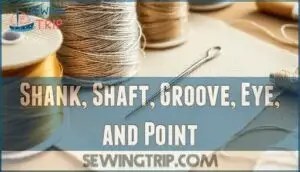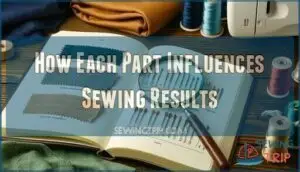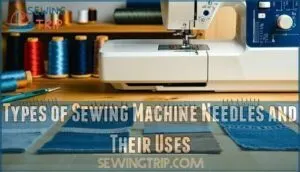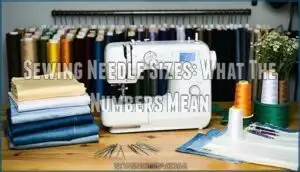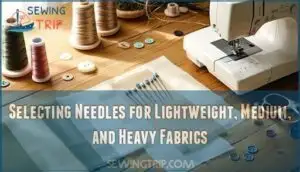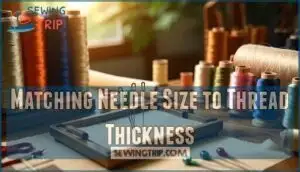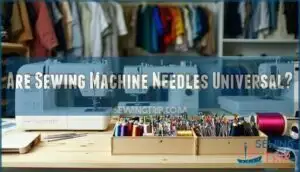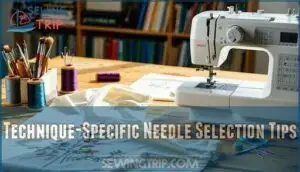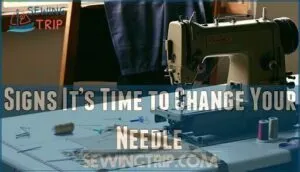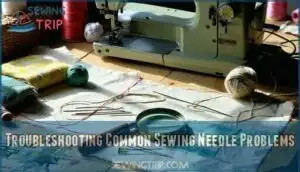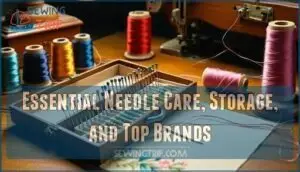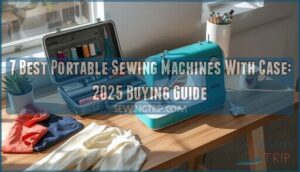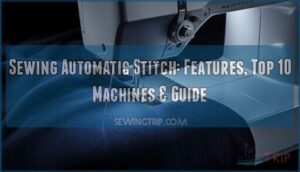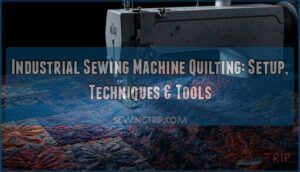This site is supported by our readers. We may earn a commission, at no cost to you, if you purchase through links.
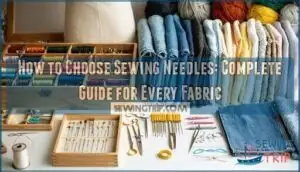
Needle size matters more than most people realize. You’ll see two numbers on packages—European (60-120) or American (8-18)—and they tell you how thick the needle is.
Lighter fabrics like silk need smaller numbers, while denim and canvas call for bigger ones. The right needle shouldn’t fight the fabric; it should slip through like it belongs there.
If you’re working with something delicate like chiffon, reach for a 70/10. Heavy upholstery? That’s 100/16 territory.
Specialty needles like leather or topstitching types handle specific materials better than all-purpose options. Getting this trinity right transforms frustrating projects into smooth sailing—and there’s more to the story than matching numbers to fabric.
Table Of Contents
- Key Takeaways
- Why Needle Choice Matters for Sewing Success
- Anatomy of a Sewing Needle Explained
- Types of Sewing Machine Needles and Their Uses
- Sewing Needle Sizes: What The Numbers Mean
- How to Match Needles to Fabrics and Threads
- Technique-Specific Needle Selection Tips
- Signs It’s Time to Change Your Needle
- Troubleshooting Common Sewing Needle Problems
- Essential Needle Care, Storage, and Top Brands
- Frequently Asked Questions (FAQs)
- Conclusion
Key Takeaways
- Choosing the right needle means matching three factors—needle type (universal, ballpoint, sharp), size (60/8 for delicates to 110/18 for heavy fabrics), and your specific fabric weight—because mismatched needles cause skipped stitches, fabric damage, and tension problems.
- Replace your needle every 6-8 hours of sewing time or after each project with heavy fabrics like denim or leather, since worn needles increase thread breakage by 30-50% and cause most common sewing frustrations.
- Specialty needles outperform all-purpose options for specific materials—leather needles use cutting points that prevent tearing, stretch needles have deeper scarfs to avoid skipped stitches on elastane, and microtex needles reduce visible holes in silk by 40-70%.
- Thread thickness dictates needle eye size just as much as fabric weight does—fine threads need 60/8-75/11 needles, all-purpose thread pairs with 80/12-90/14, and heavy decorative threads require 100/16-110/18 to prevent shredding and jamming.
Why Needle Choice Matters for Sewing Success
Your needle choice affects every single stitch you make.
Pick the wrong one, and you’ll deal with skipped stitches, puckered seams, or fabric damage. Get it right, and your machine runs smoothly while your fabric stays intact.
Impact on Stitch Quality and Fabric Integrity
Your needle choice matters more than you’d think. Pick the wrong one, and you’re looking at puckered seams, snagged fabric, or stitches that won’t survive the first wash.
Here’s what happens when you match—or miss—the right needle:
- Stitch appearance depends on matching needle size to fabric weight and thread thickness
- Seam strength suffers when needle sharpness can’t penetrate cleanly without fabric stress
- Thread tension becomes uneven with wrong needle types, causing thread breakage
- Fabric damage happens when needles create holes too large or snag delicate fibers
Your stitch quality starts with smart needle selection.
Preventing Skipped Stitches and Fabric Damage
Skipped stitches and fabric damage are two of the most frustrating problems you’ll face at the sewing machine, and both trace back to using the wrong needle. A dull or bent needle won’t catch the bobbin thread properly, causing skipped stitches. Meanwhile, using too-large needles or the wrong needle type can snag delicate fibers or leave visible holes.
Proper needle-fabric pairing prevents these issues—ballpoint needles glide through knits without snagging, while sharp microtex needles pierce silk cleanly without pulls.
How Needle Selection Affects Sewing Machine Performance
Your needle does more than just pierce fabric—it’s the difference between a machine that purrs and one that fights you. Pick the wrong needle, and you’re asking for skipped stitches, frayed thread, and a motor that’s working overtime just to keep up.
A mismatched needle throws everything off balance. Your feed dogs struggle to grip, friction builds against the needle plate, and threads snap mid-seam. The right needle? It keeps stitches even, prevents those annoying skips, and lets your machine do what it does best—without straining or damaging your fabric.
Anatomy of a Sewing Needle Explained
A sewing needle isn’t just a pointed piece of metal—it’s made up of five distinct parts that work together to create clean, consistent stitches.
Your sewing needle has five distinct parts, and each one plays a role in getting clean, consistent stitches.
Shank, Shaft, Groove, Eye, and Point
Every needle has five key parts working together—the shank, shaft, groove, eye, and point—and understanding what each one does will help you troubleshoot problems and pick the perfect needle every time.
A needle isn’t just a needle—it’s got five parts working in sync: the shank, shaft, groove, eye, and point. Once you know what each one does, you’ll stop guessing and start choosing the right needle with confidence.
The shank locks into your machine, and the shaft sets the needle’s strength and thickness. The groove keeps your thread flowing smoothly down to the eye, which holds the thread and changes size depending on what you’re working with.
Points come in different shapes—sharp for woven fabrics, rounded for knits—so you’re either piercing through or slipping between fibers.
How Each Part Influences Sewing Results
Point shape is the first line of defense—sharp points pierce dense weaves cleanly, while rounded tips slip between knit fibers without snagging. Groove design matters too; a mismatch can increase thread shredding by over 40%.
Eye size affects breakage—too small, and incidents jump 35%. The scarf function ensures your bobbin hook catches loops properly, preventing skipped stitches.
Types of Sewing Machine Needles and Their Uses
Not all needles work the same way, and picking the right one makes a real difference in how your project turns out.
Different needles handle different jobs, and the one you choose directly affects your results.
Universal, Ballpoint, and Stretch Needles
Not all fabrics play by the same rules, and choosing between universal, ballpoint, and stretch needles can mean the difference between smooth stitches and a frustrating mess. Here’s what you need to know about needle point shapes and fabric compatibility:
Picking the right needle isn’t just about size—the point shape matters just as much. Universal needles have slightly rounded tips that handle most woven fabrics like cotton and linen without a hitch.
Ballpoint needles have rounder points that slip between fibers instead of piercing them, which is exactly what you need for knits to avoid snags or runs.
Stretch needles come with specially designed eyes and deeper scarfs for high-elastane materials, so your stitches won’t skip when you’re working with activewear or swimsuit fabrics.
- Ballpoint needles feature rounder points that slip between fibers instead of piercing them, making them perfect for knit fabric needs and preventing common sewing issues like snags or runs.
- Stretch needles have specially designed eyes and deeper scarfs for high-elastane materials, making sure your stitches don’t skip when working with activewear or swimsuit fabrics.
Microtex, Jeans/Denim, and Leather Needles
When tough fabrics push your universal needle to its limit, it’s time to reach for specialty options. Microtex needles have ultra-sharp points that slice through silk and microfiber with minimal fabric puncture size, reducing visible holes by 40–70%. Jeans needles feature reinforced blades that boost denim stitch consistency by 25% when tackling multiple layers.
Leather needles use cutting points that drastically reduce leather thread fraying compared to standard sharps. For leather projects, consider using needles with smaller eyes and blunter tips for easier pulling through thick material.
Proper needle-fabric pairing prevents over 50% of tension problems and ensures your synthetic leather sewing stays smooth without skipped stitches.
Specialty Needles for Embroidery and Topstitching
Embroidery and topstitching needles turn decorative work from frustrating to perfect—because thick threads and multiple passes demand eyes and grooves built for the job.
Embroidery needles have larger eyes and deeper grooves that prevent metallic threads from shredding during machine embroidery. Topstitch needles handle heavy decorative thread without skipping stitches.
Twin needles create parallel rows, while wing needles punch decorative holes in heirloom fabrics. Match your technique-specific needle selection to your project’s demands.
Sewing Needle Sizes: What The Numbers Mean
When you look at a sewing needle package, you’ll see numbers like 80/12 or 90/14—but what do they actually mean?
Ever picked up a pack of sewing needles and wondered what those numbers mean? You know—80/12 or 90/14. Turns out, they’re not random.
These numbers tell you how strong your needle is, which matters when you’re working with different fabrics. The sizing uses both European and American measurements, and once you understand how they work together, choosing the right needle gets a lot easier.
European Vs. American Sizing Systems
You’ll see needle sizes marked two ways: the European system uses metric measurements (60 to 120), while the American system uses numbers 8 to 18. When you spot "80/12" on a package, that’s both—80 is the European size (0.8mm diameter), and 12 is the American equivalent.
- European sizes are precise: Each number equals the needle’s diameter in hundredths of a millimeter
- American numbers don’t match measurements: Size 14 doesn’t mean 1.4mm—it corresponds to 0.9mm (European 90)
- Most packages show both: Dual labeling like "90/14" helps you work with any pattern or guide globally
Choosing Needle Size for Fabric Weight
The heavier your fabric, the bigger your needle needs to be—it’s that simple.
Fine needles (60/8 to 70/10) work best for silk or chiffon, while medium needles (80/12 to 90/14) handle quilting cotton and linen. For denim or canvas, you’ll need heavy fabric needles (100/16 to 110/18).
The middle ground rule? Start with 80/12 and adjust based on how your fabric responds.
Needle Size Recommendations by Fabric Type
Once you know the size range, matching specific fabrics to exact needle numbers becomes your next move.
After you’ve figured out what size range fits your project, it’s time to pair fabrics with their needle partners.
Grab a needle size chart and treat it like your cheat sheet: silk calls for 60/8, cotton works with 80/12, denim needs the muscle of 100/16.
When you’re dealing with blends or tricky fabrics, don’t forget about your thread—chunkier threads need bigger needle eyes. Getting this match right means your stitches stay sharp and your fabric stays happy.
How to Match Needles to Fabrics and Threads
Getting the right needle for your fabric and thread isn’t guesswork—it’s about pairing size and type to what you’re sewing.
Here’s how to match needles to your project so you get clean stitches without damaging your material.
Selecting Needles for Lightweight, Medium, and Heavy Fabrics
Now that you understand needle sizing, your next task is matching those numbers to your fabric—because a delicate silk scarf and a pair of heavy denim jeans can’t share the same needle without consequences.
You’ve got the sizing numbers down—so let’s match them to your fabric. A silk scarf and heavy denim can’t use the same needle without trouble.
Here’s the breakdown: lightweight fabrics need fine needles (60/8–70/10) to avoid damage, medium-weight materials work best with 80/12–90/14 for clean stitches, and heavy fabrics require sturdy 100/16–110/18 needles to handle thicker thread and prevent breakage.
Matching Needle Size to Thread Thickness
Fabric weight tells you which needle to reach for, but thread thickness is what seals the deal—use too thin a needle with thick thread and you’ll get shredding, jamming, or broken needles before you finish a single seam. Here’s your thread weight guide for best tension:
You’ve picked the right needle for your fabric, but if you ignore thread weight, you’re in for trouble—pair thick thread with a too-small needle and you’ll end up with broken needles, shredded thread, or jamming mid-seam.
Match your thread weight to your needle size for tension that actually works:
- All-purpose threads (40-weight) pair with 80/12–90/14 needles for preventing shredding and blending threads invisibly into medium fabric weight.
- Heavy threads (30-weight or lower) need 100/16–110/18 needles to avoid jamming and maintain smooth needle sizing compatibility.
Are Sewing Machine Needles Universal?
Most home machines aren’t as picky as you’d think—over 99% use the same 130/705H needle system, meaning universal needles from Schmetz, Singer, or Brother fit Janome, Pfaff, and most brands interchangeably. That’s needle standardization at work, giving you system compatibility and brand interchangeability without guesswork.
But universal exceptions exist: industrial machines, sergers, and vintage models need their own needle types, and using the wrong one tanks performance—skipped stitches jump 70% with mismatched needles. Choosing the right sewing machine needle means knowing your machine’s system first.
Technique-Specific Needle Selection Tips
Different sewing techniques need different needles to work right. Here’s what to reach for when your project goes beyond basic seams.
Topstitching and Quilting: Needles for Thick Threads
When you’re working with heavy topstitching thread or piecing through multiple quilt layers, your standard needle just won’t cut it—you need one built for the job. Here’s what to reach for:
- Topstitch needles (sizes 90/14 to 100/16) feature extra-large eyes that accommodate thick thread without shredding
- Quilting needlepoints are slightly tapered to pierce through fabric layers cleanly during piecing
- Thread weight matters—heavier topstitching techniques need size 100/16 needles to prevent breakage
- Needle selection affects lifespan—undersized needles dull faster when pushing through dense weaving
- Match needle sizes to your fabric layers—three-plus quilt layers demand stronger, larger needles
Change your needle more frequently with these techniques since the extra stress shortens its useful life.
Stabilizing Leather, Knits, and Stretch Fabrics
Each of these tricky fabrics throws its own curveball at your machine, but the right needle turns potential disasters into smooth, professional seams. Here’s your quick-reference guide:
| Fabric Type | Needle Choice | Why It Works |
|---|---|---|
| Leather | Leather needles (90/14–110/18) with cutting points | Sharp wedge-shaped tips pierce cleanly without tearing, no leather backing needed |
| Knit fabrics | Ballpoint or stretch needles (75/11–90/14) | Rounded tips slip between fibers instead of breaking them |
| Stretch fabric | Stretch needles with special scarf design | Prevents skipped stitches on high-elastane materials like activewear |
Pair stretch interfacing or knit stabilizers with seams that need extra strength—they prevent wavy hems without fighting the fabric’s natural give.
Embroidery, Decorative, and Specialty Techniques
Specialty techniques demand specialty needles—because standard equipment won’t cut it when you’re pushing decorative thread through multiple fabric layers or coaxing metallic strands into perfect embroidery loops.
Machine embroidery needles have larger eyes and deeper grooves to handle rayon or polyester embroidery threads without shredding. For free-motion quilting, pair a sharp universal or quilting needle with specialty feet that let fabric glide smoothly.
Metallic threads need metallica or topstitch needles to prevent breakage, while needle felting requires barbed felting needles—not sewing machine types at all.
Signs It’s Time to Change Your Needle
Your needle won’t last forever, and knowing when to swap it out can save you from frustration and ruined fabric.
Here’s what to watch for so you can catch problems before they turn your project into a headache.
Needle Breakage, Dullness, and Bent Needles
Your needle isn’t going to tell you it’s past its prime—but your fabric will. A bent needle causes uneven stitches and weird thread tension. Dullness effects show up as snagging or popping sounds when you sew. Needle breakage often means you’ve pushed a worn needle too far.
For breakage prevention and better needle lifespan, change needles every eight hours of sewing time and use proper storage solutions to avoid fabric damage.
Recognizing Skipped Stitches and Fabric Snags
Skipped stitches are like a sewing machine’s way of saying "something’s wrong"—and ignoring them only makes things worse. Fabric snags and pulls mean the point is damaged or bent. When your needle deflects or becomes dull, it can’t properly catch the bobbin thread, creating gaps in your seam.
Poor thread quality and tension issues make it harder to spot needle problems, but fabric damage won’t lie. Check your needle first when troubleshooting needle issues—it’s usually the culprit.
Recommended Needle Replacement Frequency
Most sewing experts agree: change your needle every 6–8 hours of sewing time or after completing 8 projects. That simple habit prevents most common sewing mistakes and keeps your machine running smoothly. Here are the replacement timeframes you need to know:
- General sewing: Replace after 6–8 hours of active stitching time
- Heavy fabrics (denim, canvas, leather): Change after each project—these materials cut needle life by 50%
- Delicate fabrics (silk, knits): Swap needles between projects to avoid snags and skipped stitches
- Embroidery work: New needle every 8 hours or after 1–2 garment runs
- High-friction materials (vinyl, waxed canvas): Replace in just 4–5 hours to prevent fabric damage
Extended use beyond these intervals causes thread breaks to jump 30–50% and skipped stitches to spike by 40%. Regular needle replacement isn’t just good sewing machine maintenance—it’s your best troubleshooting strategy for needle issues. When you inspect a needle under magnification after 6 hours, you’ll spot micro-burrs and tip flattening that wreck stitch quality.
Brand recommendations from major manufacturers universally back starting each new project with a fresh needle. Think of needle maintenance as insurance: a tiny investment that prevents costly fabric damage and frustrating do-overs.
Troubleshooting Common Sewing Needle Problems
Even experienced sewers hit snags when the wrong needle causes unexpected problems. Let’s walk through the most common issues you’ll face and how to fix them quickly.
Fabric Getting Pulled or Damaged
If you notice puckering, snags, or holes where they shouldn’t be, your needle is likely the culprit. A dull or wrong needle point can tear fibers instead of slipping through them cleanly.
Check this quick guide:
| Problem | Likely Cause |
|---|---|
| Puckering or pulled threads | Needle too large for fabric type, or tension issues with feed dogs |
| Snags or runs in knits | Sharp needle point instead of ballpoint |
| Visible holes in delicate fabric | Wrong needle selection for fabric weight |
Match your needle type to your fabric, and swap it out if it’s bent or dull—it’s the fastest fix for fabric damage near the needle plate.
Skipped Stitches and Inconsistent Tension
Once fabric damage is under control, frustrating stitch gaps often mean your needle isn’t meeting the bobbin thread at the right moment—or it’s simply the wrong tool for your material.
Try a fresh needle first—worn ones cause skipped stitches and thread breakage. Check thread compatibility with your needle size, adjust your presser foot pressure for proper fabric feed, and make sure tension adjustments match your material’s weight to restore stitch quality.
Fixing Needle Breakage and Thread Issues
Broken needles and shredded thread aren’t just annoying—they’re signals that your machine is fighting against mismatched tools, improper technique, or hidden mechanical issues. Check for bent needle signs first, then match needle size to fabric weight.
Thread tension problems and thread breakage often stem from incorrect needle types or dull points. Switch to fresh needles every eight hours of sewing, verify proper threading, and adjust tension settings to eliminate skipped stitches and prevent fabric damage.
Essential Needle Care, Storage, and Top Brands
Taking care of your needles properly keeps them working well and helps you grab the right one when you need it.
Let’s look at simple ways to store your needles, which brands sewers trust most, and handy tools that make working with needles easier.
Safe Handling and Organization Tips
Beyond troubleshooting problems, keeping your needles organized and handled safely protects both you and your tools from unnecessary wear and accidents. Store different needle types in labeled containers or a magnetic holder so you won’t mix them up.
Keep a simple needle inventory to track when replacement is due. Always dispose of bent or dull needles in a sharps container for injury prevention, and never leave needles loose in your sewing basket where they could cause accidents.
Recommended Needle Brands for Quality
Regarding top needle brands for sewing machines, you’ll find several standouts. Schmetz leads in durability and performance, lasting through project after project. Organ needles offer affordability without sacrificing quality, especially for high-volume work. Bohin’s French-made needles feature a superb polish that resists tarnishing. John James provides variety for hand-stitching needs, while Groz-Beckert delivers precision for specialized tasks.
Investing in quality sewing needles from these trusted brands means fewer headaches and better results.
Tools to Make Needle Selection and Use Easier (e.g., Threaders, Guides)
Having the right tools on hand can turn needle changes from a fumbling chore into a quick, confident swap. A few simple accessories make needle selection and threading smoother, especially when your sewing machine needle eye feels impossibly small.
- Needle threaders guide thread through the needle eye effortlessly, saving eyestrain and frustration
- Needle gauges help identify your sewing machine needle size at a glance without squinting
- Magnetic pin cushions keep needles secure and organized during swaps
- Seam rippers safely remove stitches when you’ve used the wrong needle for your fabric
Frequently Asked Questions (FAQs)
How to choose a sewing machine needle size?
Like choosing the right key for a lock, selecting needle size starts with understanding needle size charts and fabric thickness. Use a needle size chart to match your fabric weight—lighter fabrics need smaller needles (60/8–75/11), medium-weight materials work with 80/12–90/14, and heavy fabrics require larger sizes (100/16–110/18).
Start by checking a needle size chart—it’s your roadmap to matching fabric weight with the right needle.
Lighter fabrics like silk or chiffon work best with smaller needles (60/8–75/11).
Medium-weight cotton or linen? Go with 80/12–90/
Heavy materials like denim or canvas need the larger sizes (100/16–110/18).
What sewing machine needles do I Need?
Think about needle material, sewing speed, and machine compatibility first. Choosing the right needle means understanding needle types and fabric thickness.
Universal needles suit most projects, but matching thread compatibility and selecting needle size ensures fabric and needle compatibility for professional results.
How do I choose the right needle type for my fabric?
Start by examining your fabric’s weight, weave, and stretch. Universal needles handle most woven materials, but knits need ballpoint tips to avoid snags.
Choosing the right needle means matching needle types to fabric density and thread compatibility for clean, skip-free stitches.
Are hand sewing needles compatible with a sewing machine?
No, hand needles and machine needles aren’t compatible. Hand needles lack the flat shank required for machine needle clamps.
Machine needles feature specialized grooves, eyes, and points designed for high-speed stitching and proper thread tension—something hand sewing tips can’t replicate.
What are the different types of sewing needles?
Needles come in several types for different fabric compatibility and sewing machine compatibility. Universal needles handle most woven fabrics.
Ballpoint needles have rounded points for knits, while stretch needles tackle high-elastane materials.
Denim needles pierce heavy fabrics, and leather needles feature cutting points for tough materials.
Why should you choose the right needle for your sewing machine?
Why does needle selection matter so much? Choosing the right needle ensures sewing precision, protects fabric safety, and maintains machine performance.
Proper needle types and sizing improve thread compatibility and needle efficiency, preventing costly mistakes.
Can you reuse or sharpen old sewing needles?
Why toss a needle when it still looks okay? Don’t reuse or sharpen old sewing needles—refurbishing needles compromises needle function and anatomy.
Proper needle replacement every eight hours prevents fabric damage. Understanding needle maintenance means recognizing when needle sizing and performance decline, making disposal safer than attempted sharpening methods or needle reuse.
How do needle coatings affect sewing performance?
Coatings can be game-changers for your sewing machine needle. Titanium, chrome, or Teflon coatings reduce fabric friction and prevent thread adhesion, helping needles glide smoothly through layers.
Microtex needles often feature these coating materials, improving needle types’ performance and extending their lifespan. Proper needle sizing still matters most.
What causes needles to heat up during use?
Friction causes needles to heat up during high-speed sewing. When your sewing machine needle pierces fabric repeatedly, thread friction and machine vibration generate heat.
Heavier fabric weight and incorrect needle types or needle sizes intensify this, potentially causing skipped stitches or needle breakage.
How do industrial needles differ from home models?
As the saying goes, "The right tool makes all the difference." Industrial materials like hardened steel set heavy-duty applications apart—these machine needles handle thousands of stitches per hour without flexing.
Heavy-duty sewing demands heavy-duty equipment. Industrial materials like hardened steel make all the difference here—these machine needles power through thousands of stitches per hour without bending or breaking.
Conclusion
Like a compass pointing true north, knowing how to choose sewing needles guides every stitch toward success. Match your needle type to fabric structure, align size with weight, and pair point style with material texture.
Choosing the right sewing needle isn’t rocket science, but it makes all the difference. You’ll want to match your needle type to your fabric’s structure, pick a size that fits the weight, and choose a point style that works with the texture.
These three things work together to prevent fabric damage, stop skipped stitches, and give you results that look professional. Swap out needles regularly, keep different types around, and you’ll see how the right needle takes tricky fabrics and makes them easy to work with.
Get this down, and sewing gets a whole lot smoother.
- https://www.jjneedles.com/needles-guide
- https://datahorizzonresearch.com/industrial-sewing-machine-needle-market-24770
- https://www.longancraft.com/blogs/sewing-tips/hand-sewing-needle-sizes3a-types-of-hand-sewing-needles
- https://www.sailrite.com/Selecting-a-Sewing-Machine-Needle
- https://klasseneedles.com/choosing-the-right-needle

